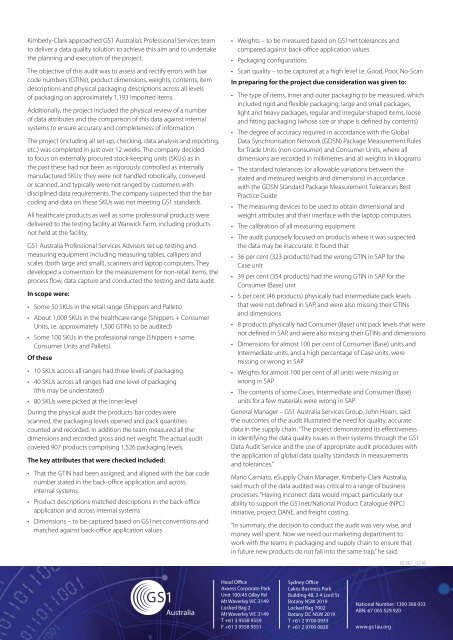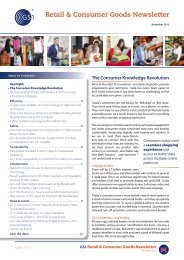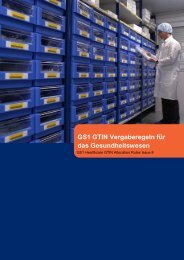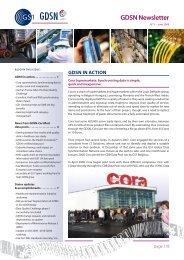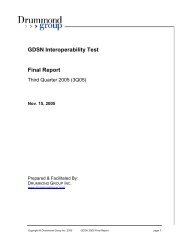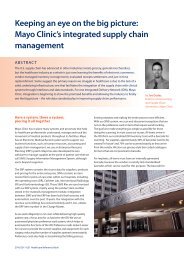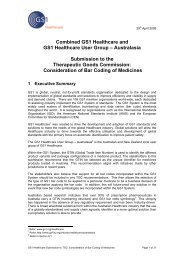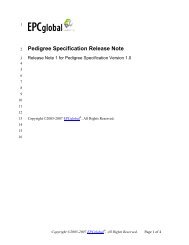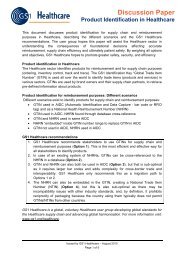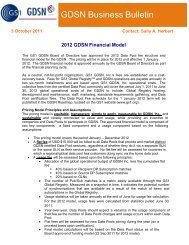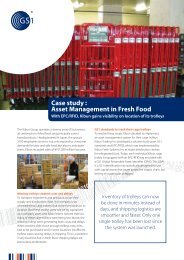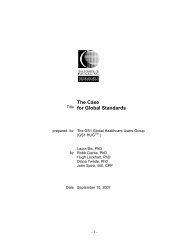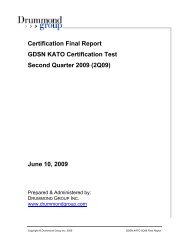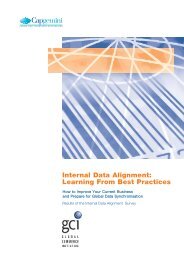Kimberly-Clark - GS1
Kimberly-Clark - GS1
Kimberly-Clark - GS1
You also want an ePaper? Increase the reach of your titles
YUMPU automatically turns print PDFs into web optimized ePapers that Google loves.
<strong>Kimberly</strong>-<strong>Clark</strong> approached <strong>GS1</strong> Australia’s Professional Services team<br />
to deliver a data quality solution to achieve this aim and to undertake<br />
the planning and execution of the project.<br />
The objective of this audit was to assess and rectify errors with bar<br />
code numbers (GTINs), product dimensions, weights, contents, item<br />
descriptions and physical packaging descriptions across all levels<br />
of packaging on approximately 1,193 imported items.<br />
Additionally, the project included the physical review of a number<br />
of data attributes and the comparison of this data against internal<br />
systems to ensure accuracy and completeness of information.<br />
The project (including all set-up, checking, data analysis and reporting,<br />
etc.) was completed in just over 12 weeks. The company decided<br />
to focus on externally procured stock-keeping units (SKUs) as in<br />
the past these had not been as rigorously controlled as internally<br />
manufactured SKUs: they were not handled robotically, conveyed<br />
or scanned, and typically were not ranged by customers with<br />
disciplined data requirements. The company suspected that the bar<br />
coding and data on these SKUs was not meeting <strong>GS1</strong> standards.<br />
All healthcare products as well as some professional products were<br />
delivered to the testing facility at Warwick Farm, including products<br />
not held at the facility.<br />
<strong>GS1</strong> Australia Professional Services Advisors set up testing and<br />
measuring equipment including measuring tables, callipers and<br />
scales (both large and small), scanners and laptop computers. They<br />
developed a convention for the measurement for non-retail items, the<br />
process flow, data capture and conducted the testing and data audit.<br />
In scope were:<br />
• Some 50 SKUs in the retail range (Shippers and Pallets)<br />
• About 1,000 SKUs in the healthcare range (Shippers + Consumer<br />
Units, i.e. approximately 1,500 GTINs to be audited)<br />
• Some 100 SKUs in the professional range (Shippers + some<br />
Consumer Units and Pallets).<br />
Of these<br />
• 10 SKUs across all ranges had three levels of packaging<br />
• 40 SKUs across all ranges had one level of packaging<br />
(this may be understated)<br />
• 80 SKUs were picked at the inner level<br />
During the physical audit the products’ bar codes were<br />
scanned, the packaging levels opened and pack quantities<br />
counted and recorded. In addition the team measured all the<br />
dimensions and recorded gross and net weight. The actual audit<br />
covered 907 products comprising 1,526 packaging levels.<br />
The key attributes that were checked included:<br />
• That the GTIN had been assigned, and aligned with the bar code<br />
number stated in the back-office application and across<br />
internal systems<br />
• Product descriptions matched descriptions in the back-office<br />
application and across internal systems<br />
• Dimensions – to be captured based on <strong>GS1</strong>net conventions and<br />
matched against back-office application values<br />
• Weights – to be measured based on <strong>GS1</strong>net tolerances and<br />
compared against back-office application values<br />
• Packaging configurations<br />
• Scan quality – to be captured at a high level i.e. Good, Poor, No-Scan<br />
In preparing for the project due consideration was given to:<br />
• The type of items, inner and outer packaging to be measured, which<br />
included rigid and flexible packaging, large and small packages,<br />
light and heavy packages, regular and irregular-shaped items, loose<br />
and fitting packaging (whose size or shape is defined by contents)<br />
• The degree of accuracy required in accordance with the Global<br />
Data Synchronisation Network (GDSN) Package Measurement Rules<br />
for Trade Units (non-consumer) and Consumer Units, where all<br />
dimensions are recorded in millimetres and all weights in kilograms<br />
• The standard tolerances (or allowable variations between the<br />
stated and measured weights and dimensions) in accordance<br />
with the GDSN Standard Package Measurement Tolerances Best<br />
Practice Guide<br />
• The measuring devices to be used to obtain dimensional and<br />
weight attributes and their interface with the laptop computers<br />
• The calibration of all measuring equipment<br />
• The audit purposely focused on products where it was suspected<br />
the data may be inaccurate. It found that<br />
• 36 per cent (323 products) had the wrong GTIN in SAP for the<br />
Case unit<br />
• 39 per cent (354 products) had the wrong GTIN in SAP for the<br />
Consumer (Base) unit<br />
• 5 per cent (46 products) physically had intermediate pack levels<br />
that were not defined in SAP, and were also missing their GTINs<br />
and dimensions<br />
• 8 products physically had Consumer (Base) unit pack levels that were<br />
not defined in SAP, and were also missing their GTINs and dimensions<br />
• Dimensions for almost 100 per cent of Consumer (Base) units and<br />
Intermediate units, and a high percentage of Case units, were<br />
missing or wrong in SAP<br />
• Weights for almost 100 per cent of all units were missing or<br />
wrong in SAP<br />
• The contents of some Cases, Intermediate and Consumer (Base)<br />
units for a few materials were wrong in SAP<br />
General Manager – <strong>GS1</strong> Australia Services Group, John Hearn, said<br />
the outcomes of the audit illustrated the need for quality, accurate<br />
data in the supply chain. “The project demonstrated its effectiveness<br />
in identifying the data quality issues in their systems through the <strong>GS1</strong><br />
Data Audit Service and the use of appropriate audit procedures with<br />
the application of global data quality standards in measurements<br />
and tolerances.”<br />
Mario Carniato, eSupply Chain Manager, <strong>Kimberly</strong>-<strong>Clark</strong> Australia,<br />
said much of the data audited was critical to a range of business<br />
processes. “Having incorrect data would impact particularly our<br />
ability to support the <strong>GS1</strong>net/National Product Catalogue (NPC)<br />
initiative, project DANE, and freight costing.<br />
“In summary, the decision to conduct the audit was very wise, and<br />
money well spent. Now we need our marketing department to<br />
work with the teams in packaging and supply chain to ensure that<br />
in future new products do not fall into the same trap,” he said.<br />
JB 987_0210<br />
Head Office<br />
Axxess Corporate Park<br />
Unit 100/45 Gilby Rd<br />
Mt Waverley VIC 3149<br />
Locked Bag 2<br />
Mt Waverley VIC 3149<br />
T +61 3 9558 9559<br />
F +61 3 9558 9551<br />
Sydney Office<br />
Lakes Business Park<br />
Building 4B, 2-4 Lord St<br />
Botany NSW 2019<br />
Locked Bag 7002<br />
Botany DC NSW 2019<br />
T +61 2 9700 0933<br />
F +61 2 9700 0820<br />
National Number: 1300 366 033<br />
ABN: 67 005 529 920<br />
www.gs1au.org


